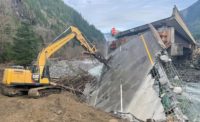Coal Ash Keeps Green Status, But Regulating It Will Cost
While environmental groups are cheering a May 4 Environmental Protection Agency proposal to regulate fly ash, utilities are concerned that potential designation of the material as a hazardous waste could prove costly.

The draft proposal would regulate for the first time coal ash under the Resource Conservation and Recovery Act (RCRA). Under the proposal, coal plants would be required to retrofit existing impoundments, which typically store the ash in liquid form, with composite liners.
Enforcing the Regulation
The more than 500-page proposal outlines two approaches to regulating the coal-combustion by-product: Both would require coal liners to be installed in surface impoundments, but they differ in how they would be enforced. The first approach, under Subtitle C of RCRA, would designate coal ash as a “special waste” and give EPA the legal teeth to enforce the regulations. The alternative approach would fall under Subtitle D of RCRA and would leave enforcement to the states.
EPA is seeking comment on both approaches and says it doesn’t want to discourage the “beneficial use” market, such as recycling coal ash for concrete. Environmental groups say they strongly prefer the Subtitle C option, and some say they believe it is the approach EPA ultimately will take. “The EPA has paved two roads, but all signs point to the hazardous-waste management scheme,” says Lisa Evans, Earthjustice senior legislative counsel.
Still, utilities wonder how they will pay for the retrofits of coal-ash ponds. Alabama Power, a subsidiary of Atlanta-based utility Southern Cos., has ash ponds at six of its powerplants in the state, but there could be as many as 25 throughout the parent utility’s network of plant sites in Southern states.
Company officials say that although they still are analyzing the proposed regulations, they would be unhappy with either option. They also worry that under the stricter regulatory option, “special waste” would in actuality be regulated similarly to “hazardous waste,” a move they strongly oppose.
“Either way, the changes represent a significant difference in the way coal ash is managed,” says Patrick Wylie, Alabama Power communications director. “We’re talking about a very expensive process that would add significant costs in terms of how we operate plants and ash facilities if either proposal is enacted.”
Another utility official wonders whether utilities will be able to use existing ash ponds, with new liners added, or have to build new ones, requiring the clearing of additional plant space. Also ambiguous is whether the proposal would require modifications to plant boilers or whether new water treatment facilities would have to be built. “We have some dry-ash systems, but will we have to treat any water that comes off that dry ash?” the official says. Further, there is concern as to whether the cost of ash compliance would prompt Southern Cos. and perhaps other utilities to close down powerplants at some sites.








